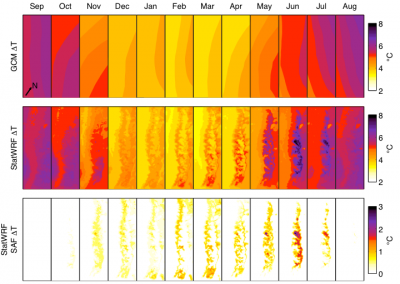Modeling Amplified Warming in Sierra Nevada Mountains Due to Snow Albedo Feedback
Snow albedo feedback is known to enhance anthropogenic climate change by increasing absorbed solar radiation in areas where snow cover is lost. The authors found that current methods for producing high-resolution ensemble climate projections do not account for this process, so they devised a statistical method that does and applied it to the Sierra Nevada mountain range.
This study raises awareness that many techniques for making regional climate change projections miss the enhanced warming due to snow albedo feedback. A new technique devised by the authors incorporates this effect and is used to make more physically defensible warming projections.
Snow albedo feedback is expected to amplify anthropogenic warming in mountain regions, such as California’s Sierra Nevada. However, the authors found that climate change projections for the Sierra Nevada made by global climate models (GCMs) and statistical downscaling methods miss this key process. In contrast, projections with a high resolution (3 km) regional climate model, which explicitly models the accumulation and ablation of the snowpack, show snow albedo feedback amplifying the warming by up to 3 °C. Regional climate models are far too computationally expensive to be run multiple times under multiple scenarios to establish probabilistic projections and measures of inter-scenario spread. So, the authors created an efficient statistical method that incorporates snow albedo feedback. This method was to project temperature and snow cover changes in the Sierra Nevada for the end of the 21st Century. These projections include local warming enhancement from snow albedo feedback that other statistical methods miss. Capturing the additional warming may be important for accurately projecting impacts on surface hydrology, water resources, and ecosystems.

